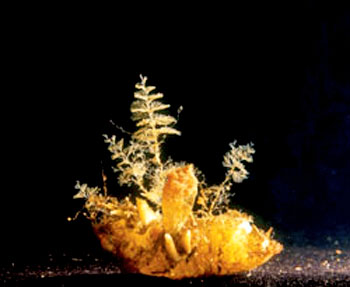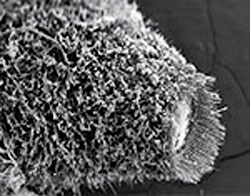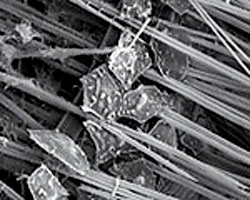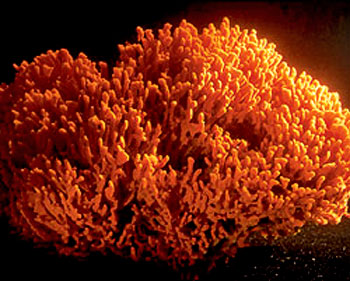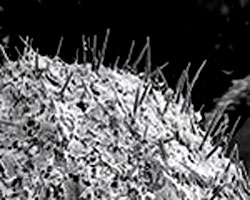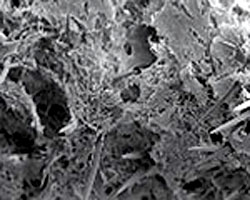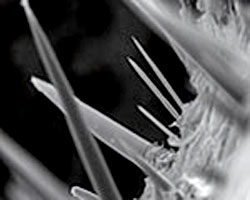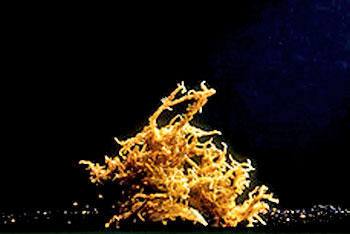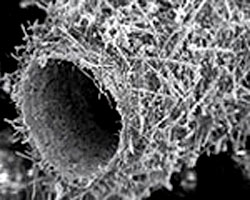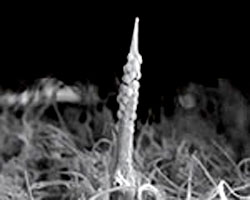|
Photography by Richard Barnes November 25, 2004 from DiscoverMagazine Website
But that raises an interesting question:
To understand what the first animals looked like, Mitchell Sogin, an evolutionary microbiologist at the Marine Biological Laboratory in Woods Hole, Massachusetts, used advanced automated DNA technology and computing power to trace the molecular evolution of dozens of today’s oldest known species - jellyfish, sea anemones, sponges, mollusks, starfish - back to their common point of origin.
When he grouped the species in the
precise order of their appearance on Earth, from less complex to
more complex, he landed on sponges.
SCYPHA
MAGNIFICATION 30x
Even Sogin was taken aback.
Perhaps even more intriguing, Sogin uncovered something older in the animal line than sponges that isn’t an animal: fungi.
His findings have implications for evolutionary studies and may even shed light on the shape of extraterrestrial life.
The discoveries have already made contributions to medicine.
Not bad for a Chicago kid who “never expected to become a scientist” and in fact had “no driving career ambitions” when he went to school.
Now, sitting in his cluttered Woods Hole office, the soft-spoken biologist says,
He opened his lab in 1989 with 5 people (now 10) and eight years later founded the Josephine Bay Paul Center for Comparative Molecular Biology, which he directs.
Both are funded by the National Institutes of Health, the National Science Foundation, and NASA.
He gazes out the window at icy Eel Pond
and Buzzard’s Bay beyond it, then throws a wistful glance at a photo
of Woods Hole in summer, when he sails his wife’s 41-foot Beneteau
sloop, Origins.
Sogin says,
There are 9,000 species growing up to eight feet tall, from the tropics to the Arctic.
They don’t visibly move or stalk prey or appear to mate; they just sit there as the world’s oceans pass through their pores, filtering as little as an ounce of food from a ton of seawater. Many even live in freshwater.
Sponges are multicellular, but the cells don’t add up to much:
But this simplicity can be deceptive.
Some sponges come armed with glasslike
skeletal spikes, microscopic and as beautiful as snowflakes. Some,
like the fire sponge of Hawaii, have surface toxins that can cause
excruciating pain to humans - and in which scientists have begun to
discover antitumor and anti-inflammatory agents.
Sponges survive handsomely on their own and can even shelter other sea creatures: Scientists found a large sponge in the Gulf of Mexico hosting 16,000 snapping shrimp and 1,000 other aquatic animals.
The sponge’s cells, its calcium
carbonate or glasslike silica spicules, and the mass of collagen
that forms its visible body all create a network of tunnels and
chambers, with little flailing hairs called cilia on the walls that
wave the water through and filter out plankton and waste. No matter
how large the sponge, it can eat only what its individual cells can
absorb.
The sperm drift along until they find their way into the tunnels and caves of another sponge. But the sponge has other reproductive options. If you push one through a sieve, breaking free its individual cells, these cells will drift until they find each other, then stick together and create an exact genetic duplicate of the parent.
If wounded, a sponge doesn’t need to grow new tissue; it simply moves old cells into the wound to close it.
These techniques have helped sponges
survive at least 500 million years. A few have remarkable
capabilities. One, living in a Mediterranean underwater cave, traps
small crustaceans with the sharp, glassy spikes jutting from its
body, then surrounds them with its cells and digests them.
One sponge, a lavender beauty called
Haliclona loosanoffi, moved four millimeters a day.
Until recently, neither side had a good
way to prove its case.
If two organisms shared characteristics - suckers on their arms, opposable thumbs, green feathers, or yellow feet - they were thought to be related. The more characteristics they shared, the closer the relationship.
That was simple:
But the method was crude, easily supporting
ambiguity and error. As scientists went deeper into
evolutionary history and closer to the base of the tree of life, the
harder it became to know how closely related organisms are.
MICROCIONA
We needed something more sophisticated, something objective, and DNA seemed like the answer.
But scientists couldn’t compare the complete genetic makeup of individuals - each has millions of components.
Sogin thought he had a better idea.
He reasoned that he could examine a limited number of genes that are present in every organism, and by comparing those and counting the differences between them, he could get quantitative measures of the similarities in any two organisms. If the two had similar gene sequences for a gene that conferred the same trait, he could infer a common ancestry.
If the gene sequences were very different, he would know they diverged a long time ago because they had evolved away from each other - simple, logical, objective.
But which genetic sequence to pick?
It had to be one that existed in all organisms and did the same job. It had to have evolved slowly enough so that one could still see genetic similarities but quickly enough to see differences. The sequence had to be easy to isolate but couldn’t jump inexplicably from one organism to another, as some genes do.
It so happened that, back in 1977, Carl Woese, Sogin’s mentor, had employed one particular gene sequence to identify a previously unknown form of life, the archaea, a discovery that transformed science’s view of biology.
The sequence is called
ribosomal RNA,
which is used by cells to create protein. It fit Sogin’s criteria
perfectly.
At the time Sogin started, 20 years ago, when DNA sequencing was in its infancy, such a project was even more ambitious than it appears now. Today Sogin concedes nonchalantly that it was “a technically difficult problem.”
A given genome might contain anywhere from 10 million to 3 billion base pairs, and Sogin was searching for just 2,000 - “a needle in a haystack.” It took a year to isolate and sequence one gene from a red sponge when he began in the early 1980s, all by hand with manual DNA sequencing gels. As he worked, gene technology improved. Within a few years, he was able to sequence 10 to 15 genes a year.
Today he can do 1,000 overnight. The
answers came in parts, but as he pieced them together, the findings
became clear.
He makes a sketch and points with his pen. The sponge was indeed at the base of animal lineage, and just above it were the cnidarians, such as jellyfish, anemones, and corals. They, like the sponge, have a saclike body form. They developed tentacles and an opening like a mouth at one end. But there were other forms of life lower down the line of descent that scientists might not have expected.
Suddenly, they made sense.
One of the sponge’s cell types is the
distinctively shaped choanocyte, a cell equipped with a tiny long
filament, called a
flagellum, surrounded by a collar studded with
even tinier hairs called
microvilli. Thousands of these flagella
beat constantly at the water and move it past the sponge’s feeding
cells.
A few of them even clump loosely together into colonies, bringing evolution to the very brink of the animal age.
Scientists had long suspected that the choanoflagellates could have been the nearest things to animals without actually being animals. At the University of Wisconsin in Madison, molecular biologists Nicole King and Sean Carroll recently verified Sogin’s results and took the story a sentence or two further.
They analyzed a different genetic sequence and found,
In one species, they discovered a
particular molecule previously found only in multicelled animals.
They concluded that the choanoflagellates appear to contain the
“genetic tool kit” from which the first animals were made.
Until Sogin was able to prove otherwise,
With a pen, he taps his evolutionary
tree sketch. Green plants form one branch, and the fungi and animals
are farther along on another branch.
The latter have become us.
LEUCOSOLENIA
Sogin’s findings have more than theoretical importance.
Endocarditis, for instance, an
inflammation of the heart muscle, can be caused by either a
bacterium or a fungus - the yeast
Candida albicans.
Sogin and his colleagues discovered something different.
But it’s with the sponge that pre-animals began to take shape, Sogin believes, because the sponge was first to grow different cell types.
For all their simplicity, sponges have “a lot of organization.” With their choanoflagellate-like choanocyte cells and a second type of cell, an archaeocyte, that can shift shape and function as needed to absorb food, secrete new skin, or reproduce, they became the first multicellular animals.
All the other animals emerged from this simple architecture and are built upon this platform.
After the sponges and cnidarians came
the worms - the first creatures with bilateral symmetry, after which
came an “explosion,” as Sogin calls it, of big-animal phyla. A
bilaterally symmetrical animal, different from front to back but a
mirror image of itself from side to side, has many subtle and
not-so-subtle advantages, among them the ability to move
purposefully forward in quest of prey, for instance.
Nobody can precisely describe those early sponges, but it’s most likely that they resembled today’s sponges.
If it weren’t for Sogin’s work, we might, on the basis of appearance, still think of them as identical.
It might even shed light on the possibility of life elsewhere in the universe.
Any life found in outer space, he
speculates, will most likely resemble early, primitive life on Earth
- something like a sponge.
|

